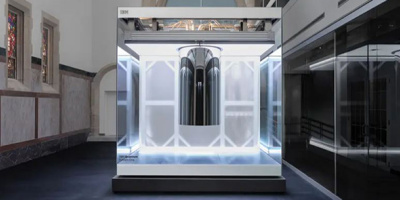Landmark 10-year partnerships with the University of Tokyo and the University of Chicago to develop a new paradigm of high-performance computing
IBM Quantum milestones to lay foundation for integration of large-scale classical and quantum systems
Collaborations will develop detailed blueprint to pioneer quantum-centric supercomputing
At the G7 Summit in Japan, IBM announced a 10-year, $100 million initiative with the University of Tokyo and the University of Chicago to develop a quantum-centric supercomputer powered by 100,000 qubits.
Quantum-centric supercomputing is an entirely new, and as of now, unrealized, era of high-performance computing. A 100,000-qubit system would serve as a foundation to address some of the world's most pressing problems that even the most advanced supercomputers of today may never be able to solve.
For example, such a powerful quantum system could unlock entirely new understandings of chemical reactions and the dynamics of molecular processes. In turn, this could enable researchers to help study climate change through modeling better methods to capture carbon; discover materials to build batteries for electric vehicles and energy grids towards the goal of being cleaner and more sustainable; and uncover more effective and energy-efficient fertilizers.
To usher in this powerful new paradigm, a global collaboration and an activation of talent and resources across industries and research institutions is being initiated. By partnering with the University of Chicago, the University of Tokyo, and IBM's broader global ecosystem, IBM will work over the next decade to advance the underlying technologies for this system, as well as to design and build the necessary components at scale.
A visual rendering of IBM Quantum’s 100,000-qubit quantum-centric supercomputer, expected to be deployed by 2033. (Credit: IBM)
Moving forward, IBM intends to expand these partnerships to include Argonne National Laboratory and Fermilab National Accelerator Laboratory, both of which are members of the Chicago Quantum Exchange and home to two respective Department of Energy quantum hubs. Importantly, the two laboratories offer capabilities and expertise that can facilitate delivering the technologies envisaged in the race to build a quantum-centric supercomputer.
"Over the past several years, IBM has been at the forefront of introducing quantum technology to the world," said Arvind Krishna, Chairman and CEO, IBM. "We have achieved significant progress along our roadmap and mission to globally establish useful quantum technology, so much so that we can now, with our partners, truly begin to explore and develop a new class of supercomputing anchored by quantum."
"Achieving breakthroughs at scale in quantum technology requires deeply rooted and productive collaboration around the world and across a broad range of industry, academic, and government partners," said Paul Alivisatos, President of the University of Chicago. "Quantum information science and technology is at a crossroad where foundational discovery and technical innovation will combine to create real breakthroughs. The University of Chicago is thrilled to partner in this endeavor."
"We expect our partnership will lead to scientific breakthroughs, acceleration of the adoption of quantum computing for the coming era, and active engagement into the critical societal challenges of humanity. We also aim to contribute to the realization of a better future society by nurturing diverse talents," said Dr. Teruo Fujii, the President of the University of Tokyo.
Building the Blocks of Quantum-Centric Supercomputing
The plans for this quantum-centric supercomputer are expected to involve innovations at all levels of the computing stack, and encompass the convergence of the fields of quantum computing and quantum communication, as well as the seamless integration of quantum and classical workflows via the hybrid cloud.
Because such a computer has never been made before, the first step will be to lay out a blueprint. The design will have to integrate classical computers and quantum computers – a challenging task to date – as well as break new ground in quantum communication and computing technology.
The foundation of this system will include milestones IBM has already outlined on its Quantum Development Roadmap
. This includes the ability to scale and connect growing numbers of quantum processors through quantum interconnects, as well as technology to mitigate errors to fully harness noisy yet powerful quantum processors.
By the end of 2023, IBM intends to debut three cornerstones of its necessary architecture for quantum-centric supercomputers. One is the new 133-qubit 'IBM Heron' processor. This processor is a complete redesign of IBM's previous generations of quantum processors, with a new two-qubit gate to allow higher performance. It will also be compatible with future extensions to enable modular connected processors to grow the size of the computer.
The second is the introduction of IBM Quantum System Two. The new flagship system is designed to be modular and flexible to introduce elements of scaling in its underlying components, including classical control electronics and high-density cryogenic wiring infrastructure. This system is targeted to be online by the end of 2023.
The third is the introduction of middleware for quantum, a set of tools to run workloads on both classical and quantum processors. This includes tools for decomposing, parallel execution, and reconstructing workloads to enable efficient solutions at scale.
Over the next decade, IBM plans to work with university partners and its worldwide quantum ecosystem to evolve how its quantum processors can be connected via quantum interconnects. This work will aim to enable high-efficiency, high-fidelity inter-processor quantum operations and a reliable, flexible, and affordable system component infrastructure to allow scaling to 100,000 qubits.
IBM's collaboration with the University of Chicago will build upon the Chicago area's strengths in quantum research. The University of Chicago seeded the region's quantum ecosystem more than a decade ago with the decision to make quantum technology a focus of what is now the Pritzker School of Molecular Engineering. Chicago has arguably become one of the leading global hubs for research in quantum technology and home to one of the largest quantum networks in the country. Scientists from the University of Chicago-headquartered Chicago Quantum Exchange, which includes Argonne National Laboratory and Fermilab National Accelerator Laboratory, four universities, more than 40 industry partners, and researchers at other world-class academic institutions in the region will continue to expand the understanding and utilization of quantum technology.
In conjunction with IBM, researchers at the University of Tokyo have been pushing forward on topics such as the detailed analysis of noise deep inside quantum processors, the development of efficient computation for quantum artificial intelligence, and quantum chemistry simulation with classical-quantum hybrid computations.
For more about the path to a 100,000-qubit quantum-centric supercomputer, read the IBM Research blog
Statements regarding IBM's future direction and intent are subject to change or withdrawal without notice and represent goals and objectives only.






















 More than ever, there is a demand for IT to deliver innovation. Your IBM i has been an essential part of your business operations for years. However, your organization may struggle to maintain the current system and implement new projects. The thousands of customers we've worked with and surveyed state that expectations regarding the digital footprint and vision of the company are not aligned with the current IT environment.
More than ever, there is a demand for IT to deliver innovation. Your IBM i has been an essential part of your business operations for years. However, your organization may struggle to maintain the current system and implement new projects. The thousands of customers we've worked with and surveyed state that expectations regarding the digital footprint and vision of the company are not aligned with the current IT environment. TRY the one package that solves all your document design and printing challenges on all your platforms. Produce bar code labels, electronic forms, ad hoc reports, and RFID tags – without programming! MarkMagic is the only document design and print solution that combines report writing, WYSIWYG label and forms design, and conditional printing in one integrated product. Make sure your data survives when catastrophe hits. Request your trial now! Request Now.
TRY the one package that solves all your document design and printing challenges on all your platforms. Produce bar code labels, electronic forms, ad hoc reports, and RFID tags – without programming! MarkMagic is the only document design and print solution that combines report writing, WYSIWYG label and forms design, and conditional printing in one integrated product. Make sure your data survives when catastrophe hits. Request your trial now! Request Now. Forms of ransomware has been around for over 30 years, and with more and more organizations suffering attacks each year, it continues to endure. What has made ransomware such a durable threat and what is the best way to combat it? In order to prevent ransomware, organizations must first understand how it works.
Forms of ransomware has been around for over 30 years, and with more and more organizations suffering attacks each year, it continues to endure. What has made ransomware such a durable threat and what is the best way to combat it? In order to prevent ransomware, organizations must first understand how it works. Disaster protection is vital to every business. Yet, it often consists of patched together procedures that are prone to error. From automatic backups to data encryption to media management, Robot automates the routine (yet often complex) tasks of iSeries backup and recovery, saving you time and money and making the process safer and more reliable. Automate your backups with the Robot Backup and Recovery Solution. Key features include:
Disaster protection is vital to every business. Yet, it often consists of patched together procedures that are prone to error. From automatic backups to data encryption to media management, Robot automates the routine (yet often complex) tasks of iSeries backup and recovery, saving you time and money and making the process safer and more reliable. Automate your backups with the Robot Backup and Recovery Solution. Key features include: Business users want new applications now. Market and regulatory pressures require faster application updates and delivery into production. Your IBM i developers may be approaching retirement, and you see no sure way to fill their positions with experienced developers. In addition, you may be caught between maintaining your existing applications and the uncertainty of moving to something new.
Business users want new applications now. Market and regulatory pressures require faster application updates and delivery into production. Your IBM i developers may be approaching retirement, and you see no sure way to fill their positions with experienced developers. In addition, you may be caught between maintaining your existing applications and the uncertainty of moving to something new. IT managers hoping to find new IBM i talent are discovering that the pool of experienced RPG programmers and operators or administrators with intimate knowledge of the operating system and the applications that run on it is small. This begs the question: How will you manage the platform that supports such a big part of your business? This guide offers strategies and software suggestions to help you plan IT staffing and resources and smooth the transition after your AS/400 talent retires. Read on to learn:
IT managers hoping to find new IBM i talent are discovering that the pool of experienced RPG programmers and operators or administrators with intimate knowledge of the operating system and the applications that run on it is small. This begs the question: How will you manage the platform that supports such a big part of your business? This guide offers strategies and software suggestions to help you plan IT staffing and resources and smooth the transition after your AS/400 talent retires. Read on to learn:
LATEST COMMENTS
MC Press Online